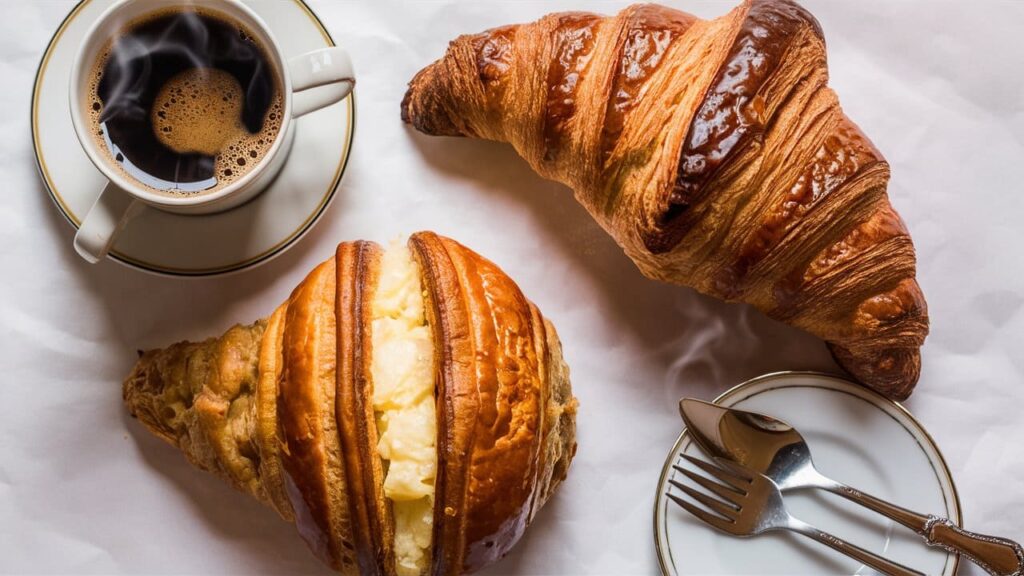Croissant and Gipfeli, both beloved pastry items in their respective cultures, often stir curiosity among culinary enthusiasts about their differences and unique characteristics. While they share similarities as variants of the classic layered pastry, each has distinct traits that set them apart. This article delves into the intricacies of these pastries, highlighting their origins, preparation methods, and the best ways to enjoy them.
Understanding the Basics
What is a Croissant?
The croissant, a buttery, flaky, and light pastry, is famous for its crescent shape and originates from France. Artisans make it from a laminated dough, which involves folding butter into the dough multiple times to create thin, layered sheets. This laminating process gives the croissant its characteristic puffiness and flaky texture once baked.
What is a Gipfeli?
Gipfeli, the Swiss-German term for croissant, enjoys widespread popularity in Switzerland. Similar to the French croissant in many ways, Gipfeli sometimes features differences in ingredients, size, and shape depending on the region. It often sports a more pronounced crescent shape and may include ingredients like whole wheat or rye flour, giving it a unique flavor and texture.
The Historical Context
Artisans in the Austrian city of Vienna first created the croissant to celebrate a victory over the Ottoman Turks in 1683. The pastry’s crescent shape was modeled after the emblem on the Turkish flag. This pastry concept later traveled to France, where it evolved into what we now recognize as the croissant. Meanwhile, the Gipfeli reflects a Swiss adaptation of the same Viennese pastry, tailored to local tastes and baking traditions.
Differences in Ingredients and Preparation
Ingredients Variations
While croissants and Gipfeli share basic ingredients like flour, butter, yeast, milk, and sugar, variations often arise in the type of flour used or additional ingredients. Some Gipfeli recipes include a touch of honey or malt, providing a slightly different flavor profile compared to the classic French croissant.
Lamination Process
The lamination process is critical in making both pastries, involving the meticulous layering of dough and butter. However, the number of layers can vary. Traditional French croissants typically have more layers, making them exceptionally flaky and airy. Gipfeli might have fewer layers, resulting in a slightly denser texture.
Baking Techniques
Both pastries require precise baking conditions to achieve the desired texture and flakiness. Croissants are often baked at a high temperature for a short period to maximize the lift from the steam produced by the butter. Gipfeli, being slightly denser, may have slightly different baking times and temperatures, influenced by the specific recipe and desired crust coloration.
Culinary Uses and Pairings
Breakfast and Coffee Pairings
Croissants are a staple in French breakfast culture, often enjoyed plain, with jams, or even filled with chocolate or almond paste. They pair beautifully with coffee, making them a popular choice in cafes across France. Gipfeli, while also enjoyed in the morning, may be found accompanying stronger Swiss coffees or enjoyed as part of a more substantial breakfast with cheeses and cold cuts.
Savory Variations
While traditional croissants are predominantly sweet or neutral, they are also used as a base for savory sandwiches. Gipfeli similarly can be adapted into savory options, stuffed with ham, cheese, or even more gourmet fillings like smoked salmon and crème fraîche.
Dessert Transformations
Croissants and Gipfeli can be transformed into luxurious desserts. A croissant might be sliced in half and topped with vanilla ice cream and hot chocolate sauce to create a decadent dessert. Gipfeli could be similarly used, perhaps paired with local Swiss chocolates and fruit compotes, showcasing its versatility in sweet applications.
Cultural Significance and Regional Variations
The croissant and Gipfeli are not just culinary delights but also carry significant cultural heritage, which is reflected in their preparation and consumption across France and Switzerland respectively.
Regional Adaptations
In France, the croissant is part of the daily life and has been adapted into various forms, including the popular “pain au chocolat,” which is essentially a croissant dough stuffed with chocolate. Meanwhile, in Switzerland, Gipfeli comes in several regional variations that might include different types of flour, such as spelt or rye, offering a heartier texture and flavor that caters to local preferences.
Symbolism and Identity
The croissant often symbolizes French culinary finesse and is a proud staple in French bakeries worldwide. Its shape and preparation are taken very seriously by artisan bakers, reflecting a broader cultural appreciation for patisserie. In Switzerland, the Gipfeli holds a similar status, often representing Swiss precision and quality in baking, and is a common feature in breakfasts across the country.
Festivals and Celebrations
Both pastries feature in various local festivals and celebrations. In France, National Croissant Day is celebrated, where bakeries showcase their craft and the streets are filled with the scent of freshly baked goods. In Switzerland, traditional breakfasts during national celebrations or local festivals often include Gipfeli, celebrated for its local variants and artisanal quality.

Modern Culinary Innovations
As global cuisine becomes more interconnected, both croissants and Gipfeli have seen innovations that merge traditional techniques with modern flavors and presentations.
Fusion Dishes
Innovative chefs have taken the classic elements of croissants and Gipfeli and fused them with international flavors. For instance, matcha croissants and red bean Gipfeli are becoming popular in places with a strong East Asian influence, offering a delightful twist on the traditional tastes.
Health-Conscious Adaptations
Responding to the growing demand for healthier options, some bakeries now offer whole grain and gluten-free versions of both croissants and Gipfeli. These alternatives cater to health-conscious consumers while maintaining the pastries’ essential characteristics.
Use in Gourmet Cooking
High-end restaurants have begun to incorporate both croissants and Gipfeli into their menus in creative ways. Croissants might be used as a base for a deconstructed sandwich, while Gipfeli could be transformed into a savory appetizer with gourmet toppings like foie gras or truffle oil.
Serving and Presentation Tips
To truly enjoy the subtleties of croissants and Gipfeli, proper serving and presentation are key. Here are some tips to enhance your experience.
Serving Temperature
Both croissants and Gipfeli are best enjoyed warm, when their buttery layers are most aromatic and their textures ideally flaky. Warming them in an oven for a few minutes can rejuvenate the layers, elevating the tasting experience.
Accompaniments
Pair these pastries with complementary beverages and sides. Croissants pair wonderfully with light and medium-bodied coffees that accentuate their buttery flavors. Gipfeli can be served with Swiss cheeses and fruit jams to highlight its more robust flavors.
Plating Aesthetics
For an appealing presentation, serve croissants and Gipfeli on wooden boards with a selection of jams, creams, and fresh fruits. This not only enhances the visual appeal but also allows guests to customize their flavors, creating a more interactive and enjoyable meal.
Integrating Croissants and Gipfeli into Everyday Meals
Expanding the use of croissants and Gipfeli beyond breakfast and dessert can add an elegant touch to any meal. Here’s how to creatively incorporate these pastries into your daily dining routine.
Light Lunch Ideas
Croissants and Gipfeli make for excellent bases in light, savory lunches. Here are a few ideas:
Croissant Sandwiches
Transform a simple sandwich into a luxurious meal by using a freshly baked croissant. Fill it with high-quality ingredients like smoked salmon, cream cheese, capers, and dill for a delightful lunch.
Gipfeli with Soup
A warm, buttery Gipfeli makes the perfect accompaniment to a bowl of hearty soup. Try it with a tomato basil soup or a rich Swiss-style potato soup to enhance the dining experience with contrasting textures.
Salad Accompaniments
Add a toasted Gipfeli, sliced and buttered, to a fresh green salad. The rich, buttery flavors of the pastry complement vinaigrette dressings and add a satisfying crunch.
Dinner Enhancements
Elevate your dinner menu by incorporating croissants and Gipfeli in innovative ways:
As a Topping
Crumble baked croissants or Gipfeli over savory casseroles or baked dishes just before serving. This adds a delightful crunch and a buttery flavor that enhances the overall dish.
Stuffed Pastries
Stuff a croissant with a mixture of cheeses, herbs, and either spinach or mushrooms for a delicious, melt-in-your-mouth dinner entree. Similarly, Gipfeli can be filled with seasoned meat or vegetable mixtures, reflecting traditional Swiss fillings.
Elegant Dessert Creations
Use croissants or Gipfeli as the base for sophisticated desserts. For instance, a croissant bread pudding infused with vanilla and rum, or Gipfeli slices layered with pastry cream and fruit for a quick and elegant trifle.

Tips for Home Bakers
For those inspired to bake their own croissants or Gipfeli, here are essential tips to ensure success:
Choosing the Right Ingredients
High-quality butter and flour are critical for achieving the perfect texture and flavor. European-style butter, which has a higher fat content, can make a significant difference in the pastry’s flakiness.
Mastering Lamination
The process of laminating dough—folding and rolling to create thin layers of dough and butter—is key to the pastry’s texture. Patience and precise temperature control are crucial; the butter should be pliable but not too soft.
Proofing and Baking
Ensure the shaped dough proofs until it is visibly puffy before baking. Bake in a preheated oven to ensure that the pastries rise well and achieve a golden, crisp exterior.
The Future of Croissants and Gipfeli in Global Cuisine
As global tastes continue to merge, the croissant and Gipfeli are likely to see new variations and uses. Food innovators and chefs are experimenting with gluten-free and vegan versions, ensuring these beloved pastries remain relevant in a health-conscious world.
You can get more recipes from here:

